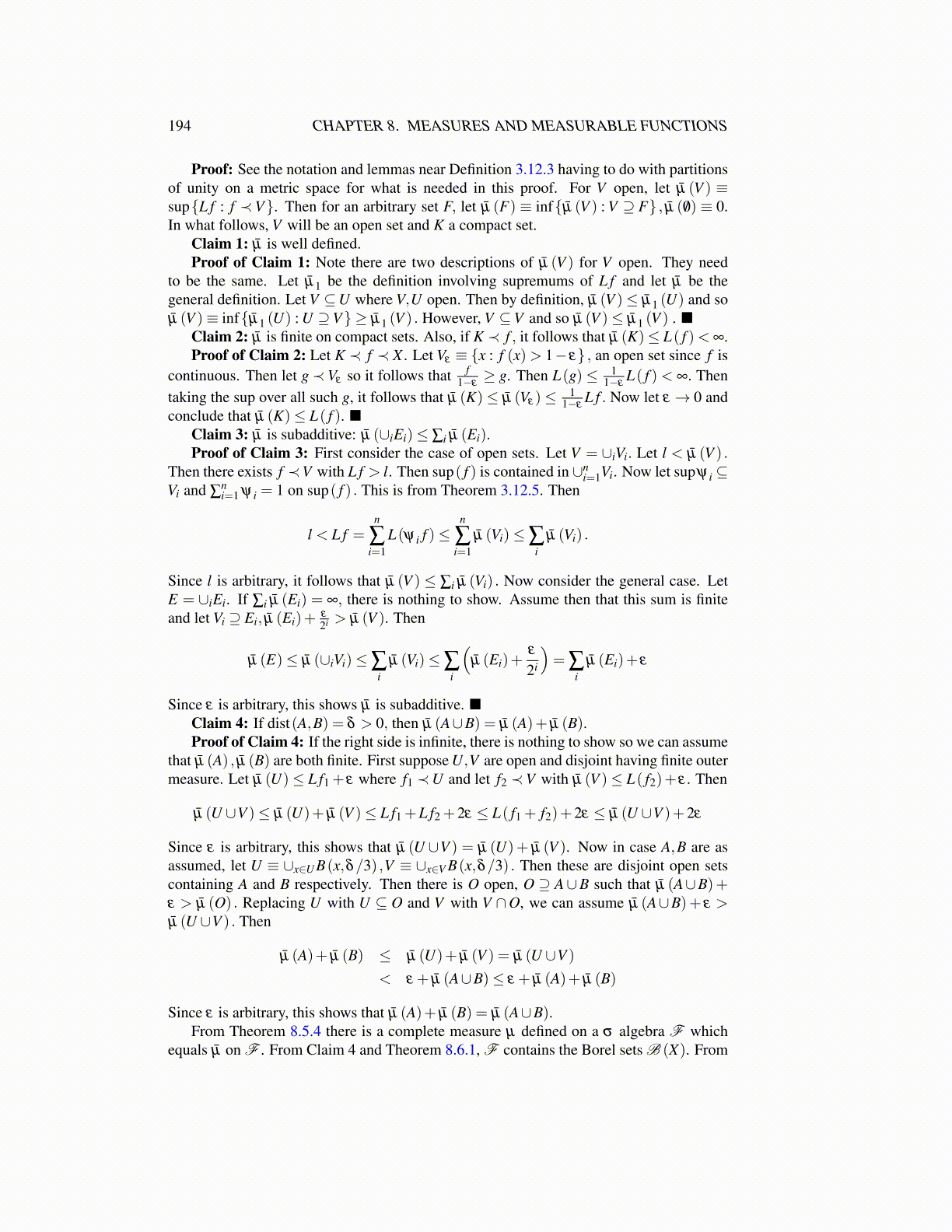
194 CHAPTER 8. MEASURES AND MEASURABLE FUNCTIONS
Proof: See the notation and lemmas near Definition 3.12.3 having to do with partitionsof unity on a metric space for what is needed in this proof. For V open, let µ̄ (V ) ≡sup{L f : f ≺V}. Then for an arbitrary set F, let µ̄ (F) ≡ inf{µ̄ (V ) : V ⊇ F} , µ̄ ( /0) ≡ 0.In what follows, V will be an open set and K a compact set.
Claim 1: µ̄ is well defined.Proof of Claim 1: Note there are two descriptions of µ̄ (V ) for V open. They need
to be the same. Let µ̄1 be the definition involving supremums of L f and let µ̄ be thegeneral definition. Let V ⊆U where V,U open. Then by definition, µ̄ (V )≤ µ̄1 (U) and soµ̄ (V )≡ inf{µ̄1 (U) : U ⊇V} ≥ µ̄1 (V ) . However, V ⊆V and so µ̄ (V )≤ µ̄1 (V ) . ■
Claim 2: µ̄ is finite on compact sets. Also, if K ≺ f , it follows that µ̄ (K)≤ L( f )< ∞.Proof of Claim 2: Let K ≺ f ≺ X . Let Vε ≡ {x : f (x)> 1− ε} , an open set since f is
continuous. Then let g≺Vε so it follows that f1−ε≥ g. Then L(g)≤ 1
1−εL( f )< ∞. Then
taking the sup over all such g, it follows that µ̄ (K)≤ µ̄ (Vε)≤ 11−ε
L f . Now let ε → 0 andconclude that µ̄ (K)≤ L( f ). ■
Claim 3: µ̄ is subadditive: µ̄ (∪iEi)≤ ∑i µ̄ (Ei).Proof of Claim 3: First consider the case of open sets. Let V = ∪iVi. Let l < µ̄ (V ) .
Then there exists f ≺V with L f > l. Then sup( f ) is contained in ∪ni=1Vi. Now let supψ i ⊆
Vi and ∑ni=1 ψ i = 1 on sup( f ) . This is from Theorem 3.12.5. Then
l < L f =n
∑i=1
L(ψ i f )≤n
∑i=1
µ̄ (Vi)≤∑i
µ̄ (Vi) .
Since l is arbitrary, it follows that µ̄ (V ) ≤ ∑i µ̄ (Vi) . Now consider the general case. LetE = ∪iEi. If ∑i µ̄ (Ei) = ∞, there is nothing to show. Assume then that this sum is finiteand let Vi ⊇ Ei, µ̄ (Ei)+
ε
2i > µ̄ (V ). Then
µ̄ (E)≤ µ̄ (∪iVi)≤∑i
µ̄ (Vi)≤∑i
(µ̄ (Ei)+
ε
2i
)= ∑
iµ̄ (Ei)+ ε
Since ε is arbitrary, this shows µ̄ is subadditive. ■Claim 4: If dist(A,B) = δ > 0, then µ̄ (A∪B) = µ̄ (A)+ µ̄ (B).Proof of Claim 4: If the right side is infinite, there is nothing to show so we can assume
that µ̄ (A) , µ̄ (B) are both finite. First suppose U,V are open and disjoint having finite outermeasure. Let µ̄ (U)≤ L f1 + ε where f1 ≺U and let f2 ≺V with µ̄ (V )≤ L( f2)+ ε . Then
µ̄ (U ∪V )≤ µ̄ (U)+ µ̄ (V )≤ L f1 +L f2 +2ε ≤ L( f1 + f2)+2ε ≤ µ̄ (U ∪V )+2ε
Since ε is arbitrary, this shows that µ̄ (U ∪V ) = µ̄ (U)+ µ̄ (V ). Now in case A,B are asassumed, let U ≡ ∪x∈U B(x,δ/3) ,V ≡ ∪x∈V B(x,δ/3) . Then these are disjoint open setscontaining A and B respectively. Then there is O open, O ⊇ A∪B such that µ̄ (A∪B)+ε > µ̄ (O) . Replacing U with U ⊆ O and V with V ∩O, we can assume µ̄ (A∪B)+ ε >µ̄ (U ∪V ) . Then
µ̄ (A)+ µ̄ (B) ≤ µ̄ (U)+ µ̄ (V ) = µ̄ (U ∪V )
< ε + µ̄ (A∪B)≤ ε + µ̄ (A)+ µ̄ (B)
Since ε is arbitrary, this shows that µ̄ (A)+ µ̄ (B) = µ̄ (A∪B).From Theorem 8.5.4 there is a complete measure µ defined on a σ algebra F which
equals µ̄ on F . From Claim 4 and Theorem 8.6.1, F contains the Borel sets B (X). From